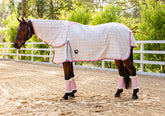Rug rub marks are a common issue for horse owners, leading to discomfort and potential skin damage for your horse. Fortunately, by ensuring your horse's rug fits correctly and is maintained properly, you can significantly reduce your horse getting rub marks.

1. Make Sure Your Rug Fits Properly
Fit is everything.
-
The rug should sit nice and high on the neckline, up past the wither at the base of the neck
-
The rug should sit firmly around the neckline and chest.
-
Both the upper and lower chest straps should be on the same buckle hole, ideally the first (tightest) or second buckle hole.
Rugs that are overly large tend to cause more rubbing issues than those that are slightly small. When a rug is too loose around the neck, it often shifts backward, putting pressure on the withers and chest. This displacement leads to excess material bunching up behind the horse, increasing the risk of the rug slipping or becoming twisted. In these cases, horses may step on the rug while lying down or rolling. To check the fit at the back, look at where the tail flap is attached. Ideally, the seam should sit right at the top of the tail. If it extends past the tail, the rug is too large; if it sits too far forward, it’s likely too small.
2. Consider Seasonal Coat Changes
From late January through early March, horses begin shedding their summer coats and growing in their winter ones. During this transition period, the coat is often more delicate and prone to rubs.
Rugs that were fine earlier in the season may start to cause irritation. It’s especially important to check for early signs of rubbing during this time and adjust your rug choices accordingly.
3. Use Bibs for Extra Protection
Horses that wear rugs for long periods—especially through the winter—are more likely to develop pressure points over time. Using a shoulder guard or chest bib underneath the rug can provide extra padding and reduce friction.
This is particularly helpful for horses with fine or sensitive coats, who may do well in lightweight cotton rugs but struggle with heavier rugs like turnout combos or fly mesh materials. A bib helps create a smooth surface between the rug and the horse’s coat, minimizing rubbing.

4. Keep Rugs Clean and in Good Condition
Dirt, sweat, and hair buildup inside a rug increases friction. Make sure to:
-
Clean Rugs Regularly: Shake off dirt daily and wash rugs every few weeks as needed.
-
Dry Thoroughly: Always let rugs dry completely before putting them back on your horse.
-
Inspect for Damage: Small tears, worn linings, or stretched straps can lead to uneven pressure and rubbing.
5. Rotate Rugs and Check Skin Often
If your horse wears a rug daily, try rotating between two rugs so the same pressure points aren’t constantly under strain. Also, check their coat frequently—especially around the shoulders, chest, withers, and hips—for early signs of rubs or irritation.






